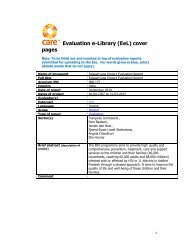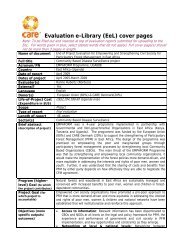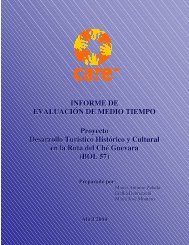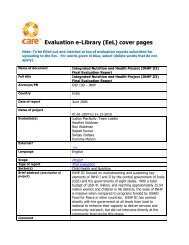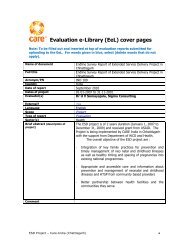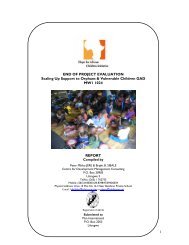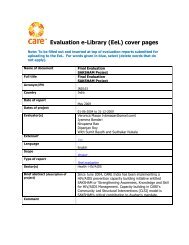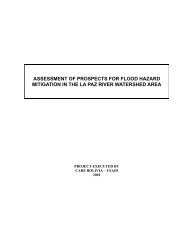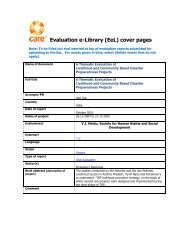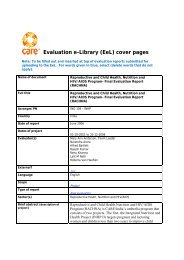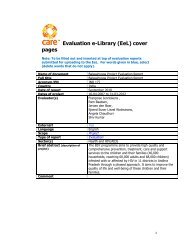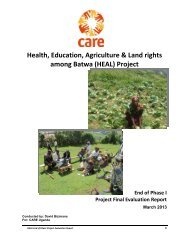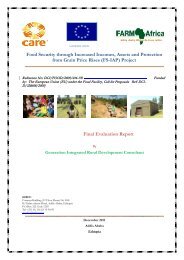IND 199 ECDE Baseline - CARE International's Electronic ...
IND 199 ECDE Baseline - CARE International's Electronic ...
IND 199 ECDE Baseline - CARE International's Electronic ...
- No tags were found...
Create successful ePaper yourself
Turn your PDF publications into a flip-book with our unique Google optimized e-Paper software.
lxxviiiTable 8.4: Knowledge of AWWs about maternal health & nutrition (Contd..)(Percentage)Particulars Intervention districts / ControlCategory of AWCsIntervention Intermediate RaigarhServices need to be provided duringpostnatal period (n=) 61 59 61Post natal check up 85.2 79.7 93.4Counseling for Infant and young child feeding 75.4 74.6 82Micronutrients (IFA, Vit A) 37.7 61 34.4Women avail micronutrients afterpost-partum period (n=) 61 59 61Yes 91.8 91.5 83.6No 1.6 3.4 6.6Don’t know 6.6 5.1 9.8The following findings have emerged from this table.• About 90 percent of AWWs perceived “TT vaccination as a component of good antenatalcare, while about four – fifths of them felt” early registration of pregnancy”, about two –thirds reported “antenatal checkup up” and 56 percent mentioned “birth preparedness”.• Other components of good antenatal care perceived by 40-55 percent of AWWs were:“rest & care”, “access to JSY” and “iron folic supplementation”. “Access to &consumption of supplement food / additional meal” and “access to convergent VHND”were perceived by least number of AWWs respectively.• Almost all of them perceived “institution delivery” as safe ,while one – third inintervention , 25 percent in intermediate and 52 percent in control AWCs felt that “homedelivery conducted by a trained health personnel” as also a safe one.• Regarding post – natal care services, more than 75 percent of AWWs reported that awoman should receive post natal checkup and should get counseling for infant andyoung child feeding. Intake of micronutrients (IFA, vitamin A) was least reported by(38% in intervention , 61% in intermediate and 34% in control AWCs)• With regard to availing of micronutrients by women after post partum period, 84 percentof AWWs or more replied in affirmative.Further, AWWs were asked about what they understand about hand washing hygienicpractice and what advice they give to mothers about sanitary practices to be followed. Theirvoluntary responses have been recorded without any prompting (Tables 8.4A in Annexure -2).• “Washing hands with water after toilet” and “washing hands with soap before eating“were reported by 53 percent and 52 percent of AWWs. The proportion of such AWWswas lower in the control district of Raigarh.• Between 40 and 50 percent of the AWWs reported: “washing hands before eating”,“washing hands with water after cleaning the child after defection”, “washing hands withsoap or ash after toilet” and “washing hand with soap or ash after cleaning the childafter defecation”. “Washing hands with soap or ash after eating” and “washing handswith soap before cooking” were reported by less than 40 percent of the AWWs.• More than 60 percent of AWWs reported that they advise mothers to wash their handsbefore cooking or serving food, to ask to child to wash hands after defecation and tomake sure that child cleans the teeth daily. About two – fifths of AWWs advice mothersto wash hands before feeding the child and to wash hands after cleaning the child afterdefecation.89 8.4 Knowledge about child health, development and nutrition8.4.1 Knowledge about neonatal care<strong>Baseline</strong> Study Of Early Childhood Care And Development Project In ChattisgarhApril,2012



